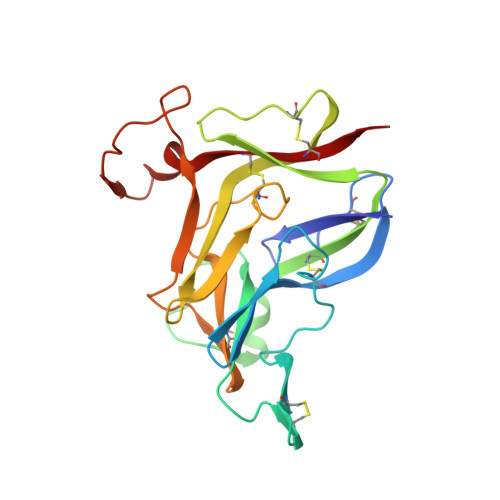The 1.9-A crystal structure of the noncollagenous (NC1) domain of human placenta collagen IV shows stabilization via a novel type of covalent Met-Lys cross-link.
Than, M.E., Henrich, S., Huber, R., Ries, A., Mann, K., Kuhn, K., Timpl, R., Bourenkov, G.P., Bartunik, H.D., Bode, W.(2002) Proc Natl Acad Sci U S A 99: 6607-6612
- PubMed: 12011424
- DOI: https://doi.org/10.1073/pnas.062183499
- Primary Citation of Related Structures:
1LI1 - PubMed Abstract:
Triple-helical collagen IV protomers associate through their N- and C-termini forming a three-dimensional network, which provides basement membranes with an anchoring scaffold and mechanical strength. The noncollagenous (NC1) domain of the C-terminal junction between two adjacent collagen IV protomers from human placenta was crystallized and its 1.9-A structure was solved by multiple anomalous diffraction (MAD) phasing. This hexameric NC1 particle is composed of two trimeric caps, which interact through a large planar interface. Each cap is formed by two alpha 1 fragments and one alpha 2 fragment with a similar previously uncharacterized fold, segmentally arranged around an axial tunnel. Each monomer chain folds into two structurally very similar subdomains, which each contain a finger-like hairpin loop that inserts into a six-stranded beta-sheet of the neighboring subdomain of the same or the adjacent chain. Thus each trimer forms a quite regular, but nonclassical, sixfold propeller. The trimer-trimer interaction is further stabilized by a previously uncharacterized type of covalent cross-link between the side chains of a Met and a Lys residue of the alpha 1 and alpha 2 chains from opposite trimers, explaining previous findings of nonreducible cross-links in NC1. This structure provides insights into NC1-related diseases such as Goodpasture and Alport syndromes.
- Max-Planck-Institut für Biochemie, Am Klopferspitz 18A, 82152 Martinsried, Germany. thn@biochem.mpg.de
Organizational Affiliation:


















